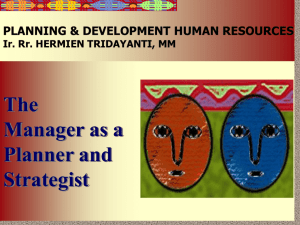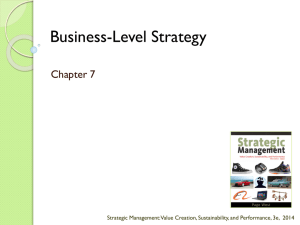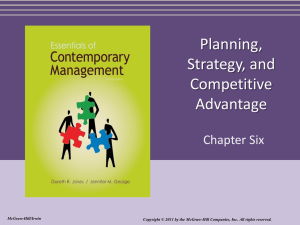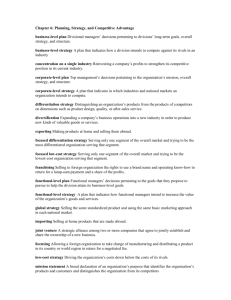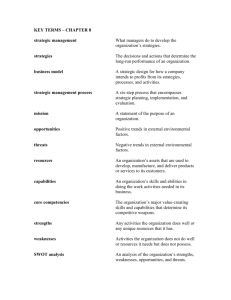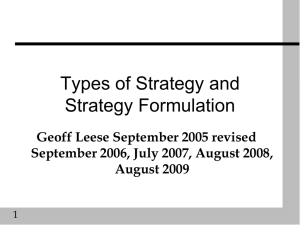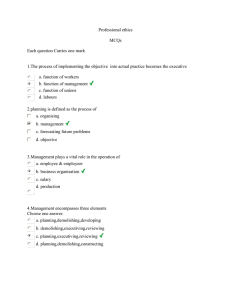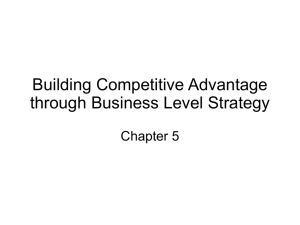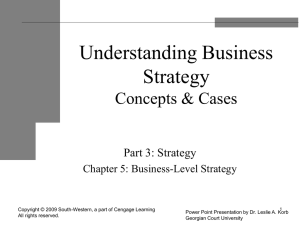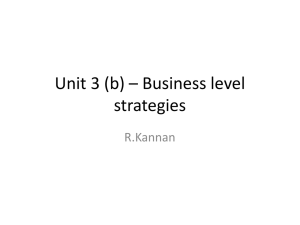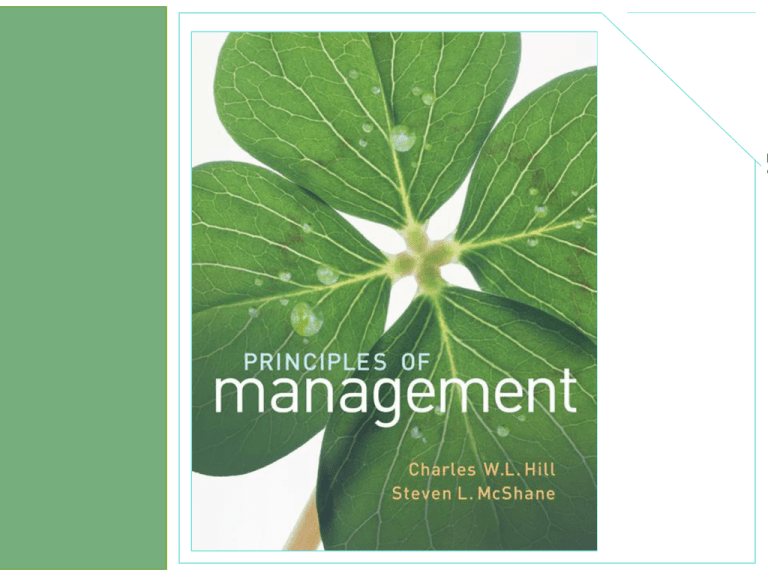
chapter
6
Strategy
McGraw-Hill/Irwin
Principles of Management
© 2008 The McGraw-Hill Companies, Inc., All Rights Reserved.
7-3
Learning Objectives
1. Define strategy.
2. Explain why the goal of strategy is to attain superior
performance.
3. Describe what is meant by competitive advantage.
4. Explain how business-level strategy can lead to competitive
advantage.
5. Explain how operations strategy can lead to competitive
advantage.
6. Explain how corporate-level strategy can lead to competitive
advantage.
7-4
Strategy
An action managers take to
attain a goal of an
organization.
7-5
Superior Performance
High
profitability
Superior
performance
requires …
Growth in
profits over
time
7-6
Wal-Mart
• First year of operation – 1962 – Rogers, Arkansas
• 1960s – 15 Wal-Mart stores
• 1979-80 – 276 stores with $1 billion in sales
• 1989 – 1,400 stores with $26 billion in sales
• 1983 – SAM’s Club
• 1988 – Supercenters
• Today -- More than 1.8 million associates worldwide,
nearly 6,500 stores and wholesale clubs across 15
countries, and over $312 billion in sales.
Source: www.walmart.com
7-7
Competitive Advantage
• Competitive advantage: Advantage obtained when a firm
outperforms its rivals.
• Distinctive competency: A unique strength that rivals lack.
• Sustainable competitive advantage: A distinctive competency that
rivals cannot easily match or imitate.
• Barrier to imitation: Factors that make it difficult for a firm to imitate
the competitive position of a rival.
• Legacy constraints: Prior investments in a particular way of doing
business that are difficult to change and limit a firm’s ability to imitate a
successful rival.
7-8
Competitive Advantage
Low costs
Distinctive
competencies
Competitive
advantage
If protected from copying by
barriers to imitation and
legacy constraints
competitive advantage
will be sustained
Product
differentiation
Superior
performance
7-9
U.S. Hospitals
• In the 20th Century, U.S. Hospitals were
considered as the premier, top-notch facilities
for healthcare
• 21st Century has brought the competitive
pressures from focused providers
• Result: Competitive disadvantage and the need
for change
Source: US Hospitals for the 21st Century, The McKinsey Quarterly, August 2006
7 - 10
Business-Level Strategy
• Business-level strategy: Strategy concerned with deciding
how a firm should compete in the industries in which it has
elected to participate.
• Low-cost strategy: Focusing managerial energy and
attention on doing everything possible to lower the costs of the
organization.
• Economies of scale: Cost advantage derived from a large
sales volume.
• Differentiation strategy: Increasing the value of a
product offering in the eyes of consumers.
7 - 11
Question
What type of business
level strategy does WalMart employ? Would
Wal-Mart be successful,
if it were to change its
business-level strategy?
Explain.
The Low-Cost Value Cycles
Lower costs
Economies
of scale
Higher
profitability
and profit
growth
Increased
demand
Lower prices
7 - 12
Option 1
Options for Exploiting
Differentiation
Increase
prices more
than costs
Higher
profitability
and profit
growth
Option 2
Successful
differentiation
Moderate or
no price
increase
Increased
demand
Economies of
scale and
lower costs
7 - 13
7 - 14
Segmenting the Market
• Markets are characterized by different types of consumers.
• Some are wealthy, some are not.
• Some are old, some are not.
• Some are influenced by popular culture, some never watch
TV.
• Some care deeply about status symbols, others do not.
• Some place a high value on luxury, some on value of
money.
7 - 15
Consumer Markets
Consumer markets segmentation characteristics:
• Geographic
• Demographic
• Psychographic
• Behavioralistic
Source: www.netmba.com
7 - 16
Choosing Segments to Serve
• Focus Strategy: Serving a limited number
of segments.
• Broad market strategy: Serving the entire
market.
Segments served
Types of Business-Level
Strategy
Many
Broad low cost
Broad differentiation
Few
Focused low cost
Focused differentiation
Low cost
Differentiation
Competitive theme
7 - 17
7 - 18
Question
In the retail industry sector, Wal-Mart could be
described as following ________ strategy,
whereas Nordstrom could be described as
following _________ strategy.
a. broad low cost; broad differentiation
b. focused low cost; broad low cost
c. broad differentiation; broad low cost
d. focused differentiation; focused low cost
Configuring the
Value Chain
• Primary activities: Activities having to do with the design,
creation, and delivery of the product; its marketing; and its
support and after sales services.
• Support activities: Activities that provide inputs that allow
the primary activities to occur.
• Organization architecture: The operations of the firm
are embedded within the internal organization architecture of
the enterprise, which includes the organization structure,
incentives, control systems, people, and culture of the firm.
7 - 19
7 - 20
Strategic Fit
Supports
Supports
Operations
strategy
Internal
organization
architecture
Businesslevel
strategy
Supports
Fits
Industry
conditions
7 - 21
Competitive Tactics
• Competitive tactics: Actions that managers take to try to
outmaneuver rivals in the market.
• Tactical pricing decisions:
- Price war
- Price signaling
- Razor and razor blade pricing
• Tactical Product decisions:
- Product proliferation
- Bundling
7 - 22
Price Wars and Signaling
• Pepsi vs. Coca-cola
• Cellular phones
• Internet services
• Long distance call rates
7 - 23
Corporate-Level Strategy
• Corporate-level strategy: Strategy concerned
with deciding which industries a firm should compete
in and how the firm should enter or exit industries.
• Vertical integration: Moving upstream into
businesses that supply inputs to a firm’s core business
or downstream into businesses that use the outputs of
the firm’s core business.
7 - 24
Disney
Is Disney (a diversified entertainment
company) vertically integrated?
- Domestic and international cable networks
- TV production and distribution
- Internet and mobile operations
- Theme parks, hotels, restaurants, and cruise line
- Animated motion pictures and licensing
- Disney Stores and Web sites
Source: finance.yahoo.com
7 - 25
Diversification
• Diversification: Entry into new business areas.
• Related diversity: Diversification into a business related to
the existing business activities of an enterprise by distinct
similarities in one or more activities in the value chain.
• Unrelated diversity: Diversification into a business not
related to the existing business activities of an enterprise by
distinct similarities in one or more activities in the value chain.


